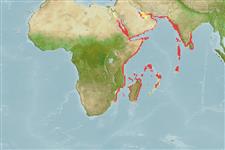Common names from other countries
>
Eupercaria/misc (Various families in series Eupercaria) >
Lethrinidae (Emperors or scavengers) > Lethrininae
Etymology: Lethrinus: Greek, lethrinia, a fish pertaining to genus Pagellus.
Environment: milieu / climate zone / depth range / distribution range
Sinh thái học
Biển Cùng sống ở rạn san hô; không di cư; Mức độ sâu 2 - 100 m (Ref. 9710). Tropical; 28°N - 26°S, 32°E - 82°E
Indian Ocean: Red Sea and East Africa to Sri Lanka. References to this species from the Central Pacific probably refer to Lethrinus atkinsoni.
Length at first maturity / Bộ gần gũi / Khối lượng (Trọng lượng) / Age
Maturity: Lm ?, range 19 - ? cm
Max length : 65.0 cm TL con đực/không giới tính; (Ref. 2295); common length : 40.0 cm TL con đực/không giới tính; (Ref. 2295); Tuổi cực đại được báo cáo: 27 các năm (Ref. 42001)
Các tia vây lưng cứng (tổng cộng) : 10; Các vây lưng mềm (tổng cộng) : 9; Tia cứng vây hậu môn: 3; Tia mềm vây hậu môn: 8. Body color is yellow to greenish-blue, becoming lighter ventrally; usually with nine or ten dusky yellow-green or brown bars. The head is purplish gray, sometimes with a red blotch on the nape. A red bar is at the base of pectoral fin, sometimes extending broadly below and above the pectoral fin base to the edge of the operculum. The base of the upper and sometimes lower rays of pectoral fin is red. The base and tips of the pelvic fins are often red. The membranes of the dorsal fin is red (sometimes restricted to the base of the fins). The anal fin is whitish with the membranes between the forward rays often red. The caudal fin, especially the tips is reddish.
Found over reef areas and adjacent sandy and seagrass areas (Ref. 30573, 41878). Feeds mainly on echinoderms (most frequently sea urchins), crustaceans and fishes; mollusks, tunicates, sponges, polychaetes and other worms are consumed in lesser quantities. A protogynous hermaphrodite (Ref. 55367). In most areas of the Red Sea, it is considered an excellent food fish but in certain areas of the Indian Ocean it may have an unpleasant 'coral' smell and taste (Ref. 2295, 11888). Utilized fresh for broiling and baking (Ref. 9987).
Sex change was found to commonly occur between the ages of 5 and 6 years (Ref. 2295). A diandric species (Ref. 55367). Length and age at sex change occur at 32 cm TL and 16 yrs, respectively (Ref. 55367).
Carpenter, K.E. and G.R. Allen, 1989. FAO Species Catalogue. Vol. 9. Emperor fishes and large-eye breams of the world (family Lethrinidae). An annotated and illustrated catalogue of lethrinid species known to date. FAO Fish. Synop. 125(9):118 p. Rome: FAO. (Ref. 2295)
IUCN Red List Status (Ref. 130435)
CITES (Ref. 128078)
Not Evaluated
Threat to humans
Harmless
Human uses
Các nghề cá: tính thương mại cao; cá để chơi: đúng
Các công cụ
Special reports
Download XML
Các nguồn internet
Estimates based on models
Preferred temperature (Ref.
115969): 25.4 - 29.2, mean 27.5 (based on 406 cells).
Phylogenetic diversity index (Ref.
82804): PD
50 = 0.5000 [Uniqueness, from 0.5 = low to 2.0 = high].
Bayesian length-weight: a=0.01380 (0.00856 - 0.02227), b=3.01 (2.88 - 3.14), in cm Total Length, based on LWR estimates for this species & Genus-body shape (Ref.
93245).
Mức dinh dưỡng (Ref.
69278): 3.8 ±0.33 se; based on food items.
Thích nghi nhanh (Ref.
120179): Trung bình, thời gian nhân đôi của chủng quần tối thiểu là 1.4 - 4.4 năm (K=0.10-0.30; tm=3; tmax=27; Fec=26,700).
Prior r = 0.50, 95% CL = 0.33 - 0.75, Based on 3 data-limited stock assessments.
Fishing Vulnerability (Ref.
59153): High vulnerability (65 of 100).
Climate Vulnerability (Ref.
125649): High to very high vulnerability (73 of 100).
